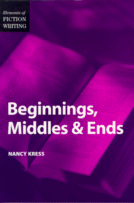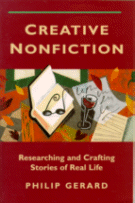Reviews of Writing Books
Page One of TwoBeginnings, Middles & Ends by Nancy Kress
Writer's Digest Books, May 1999.Paperback, 149 pages.
ISBN: 0898799058
Ordering information:
Amazon.com.
 Nancy Kress, a popular of author of science
fiction and fantasy novels including the Hugo and Nebula
award-winning Beggars in Spain,
provides valuable instruction for writers in
Beginnings, Middles & Ends. The reference,
which works its way from beginnings to endings,
allows writers to focus on the part
of their fiction they struggle with most. Each section
includes advice about what each part of
the story or novel should and should not contain,
instruction to improve writing skills,
excerpts from stories and novels that work and
exercises for writers. Highlights from the text
include The Swimming Pool Theory, for use when
creating backfill and flashbacks, a list of ways
writers get stuck in the middle of stories with
concrete advice about how to avoid and break through
them and a checklist for writing successful endings.
Nancy Kress, a popular of author of science
fiction and fantasy novels including the Hugo and Nebula
award-winning Beggars in Spain,
provides valuable instruction for writers in
Beginnings, Middles & Ends. The reference,
which works its way from beginnings to endings,
allows writers to focus on the part
of their fiction they struggle with most. Each section
includes advice about what each part of
the story or novel should and should not contain,
instruction to improve writing skills,
excerpts from stories and novels that work and
exercises for writers. Highlights from the text
include The Swimming Pool Theory, for use when
creating backfill and flashbacks, a list of ways
writers get stuck in the middle of stories with
concrete advice about how to avoid and break through
them and a checklist for writing successful endings.
Nancy Kress knows what it takes to make a story or novel great, and conveys this information effectively to the reader. She also helps writers avoid common pitfalls. Enhanced with exercises, this book contains great methods to help writers create a complete and appealing short story or novel.
Creative Nonfiction by Philip Gerard
Story Press, March 1999.Trade Paperback, 216 pages.
ISBN: 1884910432
Ordering information:
Amazon.com.
 This informative guide provides instruction on
how to research and create appealing nonfiction stories.
Author Philip Gerard, a writing program director,
freelance writer, novelist and scriptwriter,
uses experiences from his own career and numerous
interviews with famous and established writers to create
a compelling text full of practical advice that
both helps and encourages beginning nonfiction writers.
The book provides instruction on various concepts in
creative nonfiction including: finding an original subject,
researching, interviewing skills, length, telling
a true story, autobiographies, memoirs, personal essays,
style, attitude and ethics. For each concept Gerard backs
up his advice with concrete examples to show what works
and what doesn't work. Gerard's delivery is straight-forward
and upbeat; it's sure to make a positive impact on the
developing writer. Some highlights from the book include
how to ask the right questions at an interview, making
people in nonfiction stories come alive by using devices
used by fiction writers, a list of references to keep by your
writing desk and a section about how to determine the form of your nonfiction
story. These valuable ideas and many others make Creative
Nonfiction a must-read reference for nonfiction writers.
This informative guide provides instruction on
how to research and create appealing nonfiction stories.
Author Philip Gerard, a writing program director,
freelance writer, novelist and scriptwriter,
uses experiences from his own career and numerous
interviews with famous and established writers to create
a compelling text full of practical advice that
both helps and encourages beginning nonfiction writers.
The book provides instruction on various concepts in
creative nonfiction including: finding an original subject,
researching, interviewing skills, length, telling
a true story, autobiographies, memoirs, personal essays,
style, attitude and ethics. For each concept Gerard backs
up his advice with concrete examples to show what works
and what doesn't work. Gerard's delivery is straight-forward
and upbeat; it's sure to make a positive impact on the
developing writer. Some highlights from the book include
how to ask the right questions at an interview, making
people in nonfiction stories come alive by using devices
used by fiction writers, a list of references to keep by your
writing desk and a section about how to determine the form of your nonfiction
story. These valuable ideas and many others make Creative
Nonfiction a must-read reference for nonfiction writers.
Click Here For Writing Book Reviews Page Two
Return to the July 1999 issue of The IWJ.
More from Writers Write
